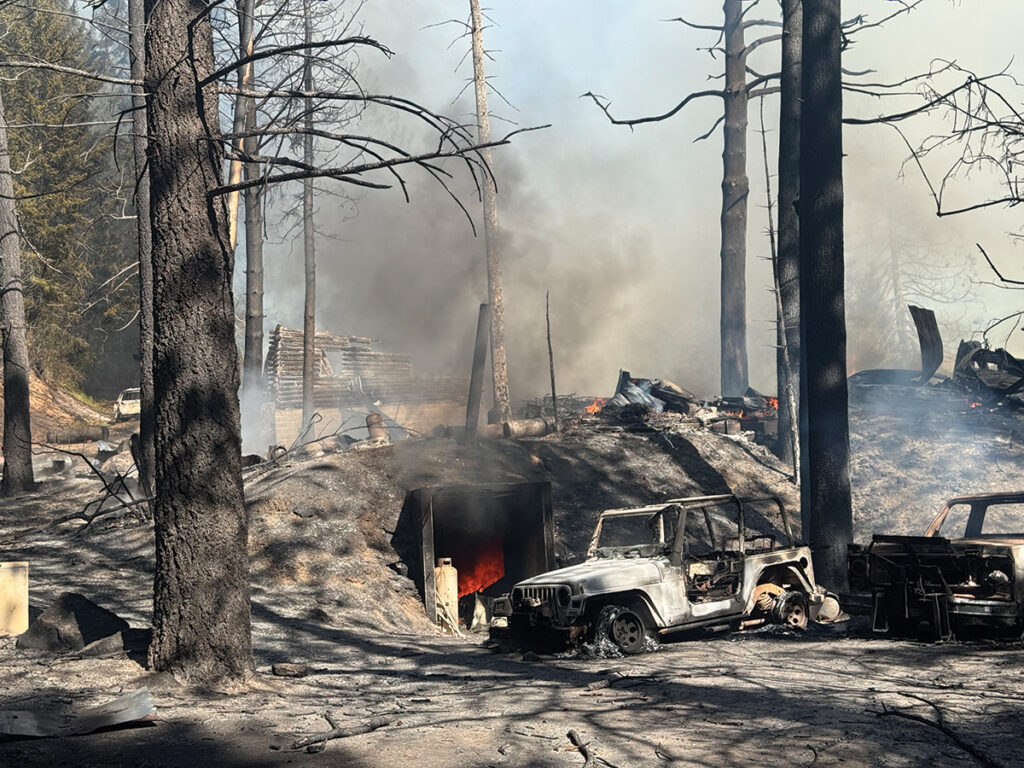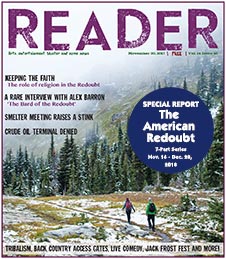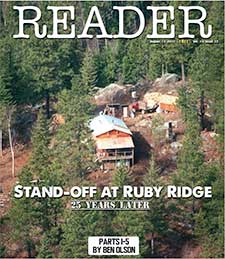State, local responders battle five-acre Laclede area fire
By Zach Hagadone
Reader Staff
First responders with Selkirk Fire & Rescue battled a blaze May 27 that grew to include multiple structures and vehicles, as well as about five acres of vegetation, triggering an evacuation order in the Laclede area that has since been lifted.
According to an alert from officials, the fire was reported around 2:41 p.m. on a section of Lower Manley Creek Road, which prompted “ready” status for residents on Upper and Lower Manley Creek before being lifted around 6:18 p.m.
Selkirk Fire responded while requesting additional resources, and thanked interagency partners such as Bonner County Emergency Management, Bonner County EMS, Bonner County Sheriff’s Office, Northside and West Pend Oreille fire districts, as well as the Idaho Department of Lands, which took over full containment around 6:50 p.m. on May 27.
No injuries were reported, though according to a May 28 update from IDL, the fire is still active, 47 crew members mopping up hot spots and reinforcing the fire line. IDL stated that a “system of hoses” has been put in place to treat flare-ups.
“There was no additional growth overnight as firefighters were able to put a line around the fire and spot fires last night,” IDL stated on May 28, adding that a four-person group of standalone initial attack firefighters were on the scene.
According to area media, the fire posed a special hazard to responders, as it included a structure housing diesel and propane. Selkirk Fire, Northside Fire and IDL worked the fire together, which included helicopter air support and a number of engines from the state agency, alongside other local resources. An investigation into the cause of the blaze is ongoing, with IDL stating May 28 that investigators with the state fire marshal’s office were on-site.
Based on the latest information from IDL, Selkirk Fire was focused on the structure fire, with four state agency engines on the scene, as well as two Forest Service groups composed of Kaniksu Wildfire and a Pulaski hand crew, one crew of IDL initial attack firefighters, two water tenders and portable water tanks, and two helicopters on standby through the afternoon of May 28.
Selkirk’s response to the fire came about a week after the May 20 election, in which voters rejected levy requests for the Northside, Sagle and Westside fire districts — all of which are helmed by Selkirk Fire Chief Jeff Armstrong.
In a May 21 statement posted on Selkirk Fire’s Facebook page, Armstrong wrote that while he respected the voters’ decision, “One of the things we saw through these discussions is that there are many folks who don’t know their fire district. For those that made statements regarding ‘waste,’ we challenge you to come in and examine our books. Perhaps through this exercise, we can regain your trust. We also saw a lot of other mis- and disinformation, on both sides of the issue, including the claim we hired a consultant for the levy. This is false.”
The Bonner County Republican Central Committee staked out a strong stance against the levies, calling them “massive tax increases” that come at a time when “taxpayers are already being pinched by record inflation and taxes for income, gas, groceries, sales taxes and other property taxes and government fees.”
If approved, the Northside Fire District levy would have raised an additional $1.2 million per year on a permanent basis, amounting to a tax of $61 per $100,000 of taxable assessed value. In Sagle, the fire district asked for a permanent increase for a total override of $750,000, resulting in a tax increase to $122 per year per $100,000 of taxable value. Likewise, Westside sought to raise an additional $810,358, also carrying a total tax burden of $122 per year per $100,000.
All three levies were intended to support recruitment and retention of firefighters; fuller staffing of area fire stations; and equipment, maintenance and general operations.
Northside’s levy was defeated 1,059 to 559 — or 65.45% to 34.55% — while Sagle’s went down 1,253 against and 741 in favor, for a margin of 62.84% to 37.16% and Westside’s was 402 against and 339 in favor, for 54.25% to 45.75%.
In his May 21 statement, Armstrong said that in the wake of the election results he’d be focusing on staffing levels and working to outfit volunteers.
Meanwhile, he is recommending removing the paid staff from the Careywood fire station in the Sagle district by Sunday, June 1. The Westside Fire District will continue with a single full-time firefighter per day, though the Samuels station in the Northside Fire District will not be staffed.
By eliminating the position in Careywood, Armstrong stated that the fire service will be able to save “a substantial amount in overtime and personnel costs,” with those funds “shifted immediately to the maintenance of our aging fleet, fire station repairs and equipment replacement.”
Armstrong stated that a recent capital replacement plan showed the need for up to $900,000 in investments over the next three to five years, including repairs and replacements to fire stations and apparatus, as well as personal protective equipment.
“The days of ‘kicking the can down the road’ are over!” he wrote. “It will be my goal to return staffing to that station [Careywood] when financially feasible. As a note: ‘impact fees’ do not allow for the replacement of current equipment, or personnel, only the purchase of new equipment. As an example: a new fire engine for a new fire station, or other projects related directly to growth.”
Armstrong stated that as he addresses personnel costs, residents should “prepare for vacancies created by firefighters who may now leave the organization.”
“Northside also has some capital needs that need to be addressed, and we will explore all the options to stay on track with those,” he added. “With Ponderay having some of the largest commercial buildings and the most significant community risk, my concern for the Northside District is a bit unique.
“Next, we will be re-examining our automatic aid agreements and response planning, potentially scaling back the number of resources we commit (initially) to any emergency. Sending resources to a call is only one aspect of operational readiness. We must also ensure there are resources available to cover the area and respond to any subsequent calls for service. Additionally, I have engaged with the Idaho Department of Lands (IDL) to coordinate and re-examine our responses to wildland/brush fire calls in the districts.”
Armstrong concluded his May 21 statement by saying that “the future will be challenging but we will remain mission focused and intent on making our fire districts some of the best in North Idaho and ones that can be admired by our community.”











 Coming up this week! Don’t miss Live Music, the Summer Sampler, the Art Party, Monarch Grind, the Sandpoint Renaissance Faire, and more! See the full list of events in the
Coming up this week! Don’t miss Live Music, the Summer Sampler, the Art Party, Monarch Grind, the Sandpoint Renaissance Faire, and more! See the full list of events in the 